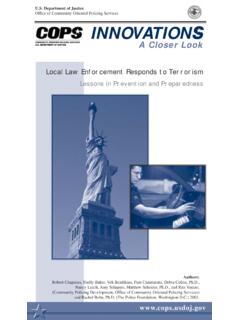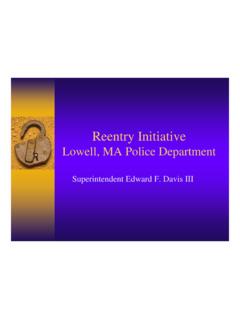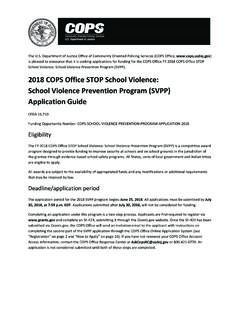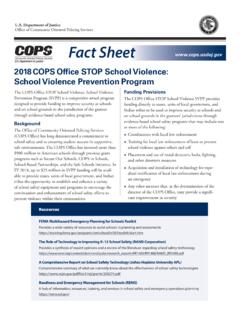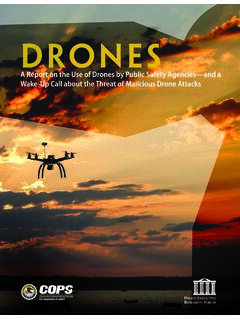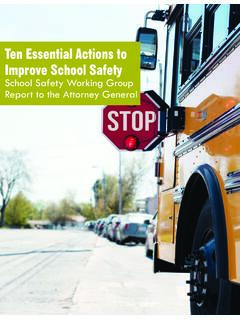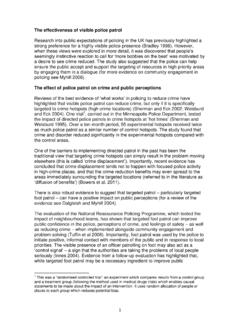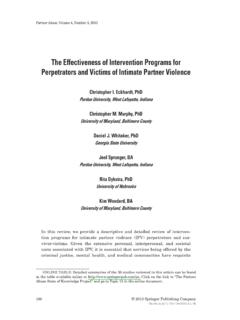Transcription of Reducing Fear of Crime - COPS OFFICE
1 Department of JusticeOffice of Community Oriented Policing ServicesReducing Fear of CrimeStrategies for PoliceGary CordnerReducing Fear of CrimeStrategies for PoliceGary CordnerKutztown UniversityJanuary 2010 This project was supported by Grant Number 2003-CK-WX-K049 awarded by the OFFICE of Community Oriented Policing Services, Department of Justice. The opinions contained herein are those of the author and do not necessarily represent the official position or policies of the Department of Justice. References to specific agencies, companies, products, or services should not be considered an endorsement by the authors or the Department of Justice. Rather, the references are illustrations to supplement discussion of the Internet references cited in this publication were valid as of July 2009.
2 Given that URLs and web sites are in constant flux, neither the authors nor the COPS OFFICE can vouch for their current Colleagues,Fear of Crime has an incredibly corrosive effect on individuals and entire communities. This issue is of great concern to all of us in law enforcement. Fear negatively shapes all aspects of the quality of life of America s communities. The COPS OFFICE recognizes that people not only need to be safe, but they also need to feel safe. Treating both of these issues as two parts of a greater whole is a critical aspect of community policing. That is why we produced this document, Reducing Fear of Crime : Strategies for police . This publication identifies promising practices that have the potential to directly address the fear of Crime . It is written by Gary Cordner, one of the foremost experts on the issue of community fear in the policing field.
3 Community policing is one of the most effective tools for Reducing the fear of Crime . When law enforcement works directly with residents and businesses within a community, they are going a long way toward Reducing Crime , improving quality of life, and enhancing public safety. I know that you will find our new publication, Reducing Fear of Crime : Strategies for police , extremely useful. Sincerely,Bernard K. Melekian Director COPS OfficeLetter from the DirectorvExecutive SummaryExecutive SummaryFear of Crime was at or near the top of the list of police priorities in the United States more than 2 decades ago, in the early 1980s. Many police executives had accepted the premise that Reducing fear of Crime was an important objective, and several promising practices had been identified. This situation helped spur the development of community policing in the 1980s and 1990s but, paradoxically, the importance of fear of Crime within the explicit missions of most police departments seemed to recede even as community policing expanded.
4 More recently, however, the gap between (1) falling Crime rates and (2) stable or even increasing levels of fear (what some call the reassurance gap) has led to renewed interest among police in strategies for Reducing fear of Crime . Also, fear of terrorism arose in America post-9/11, making fear reduction even more salient for local, state, and national Guide briefly reviews information about the phenomenon of fear of Crime as well as historical and contemporary police efforts to reduce fear. The main focus, however, is on tools and techniques that police can use to target and reduce fear of Crime , and institutionalize fear reduction within their agencies. Some promising practices and best practices have been identified these are strategies and programs that have been implemented and that have been tested and shown to be effective.
5 Fear of Crime is a different animal from Crime , disorder, or traffic, but it is not really all that esoteric. This Guide will help police understand what fear of Crime is, why it matters, and why it should be an important target of police attention. The Guide provides a number of tools and techniques that should enable any police department to successfully add fear reduction to its operational strategy and organizational bottom of this Guide was supported by the OFFICE of Community Oriented Policing Services (the COPS OFFICE ) and entailed a national survey, site visits, and extensive review of documents, reports, articles, and books. The author would like to express sincere thanks to the many experts and officials who provided information, advice, and support during the project, including Matt Lysakowski of the COPS OFFICE ; Kentucky Regional Community Policing Institute colleagues Cindy Shain, Ed Brodt, and Tracy Schiller; the research staff at Eastern Kentucky University s Justice & Safety Center, including AnnMarie Cordner, Emily Raine, Tara Rose, Jacinda Bertie-Cockerham, and Jan Mays; Mora Fiedler previously of the Denver police Department; Pat McElderry of the Colorado Springs police Department (retired); Dr.
6 Martin Innes, University of Surrey; and Gavin Stephens, Home OFFICE , United Kingdom. Special thanks go to Sergeant Neil Henson of the London Metropolitan police who helped provide access to his own agency as well as other officials and agencies in of Crime has a huge impact on American society. Individuals often choose where to live, shop, and socialize based on their perceptions of the relative safety of different cities, towns, and neighborhoods. Parents allow their their kids to play in the park or walk to school if they think it would be safe. Neighborhoods and entire cities have gone into spirals of decline because fear of Crime motivated those residents and businesses who could afford to move, to do so. Fear of Crime routinely drives local politics, occasionally influences national elections, and has been the catalyst for vastly increased federal Crime -control efforts since the 1960s.
7 Concern about heightened fear of Crime in the 1980s and 1990s helped spur the development of community policing. Since the 1990s, the actual level of Crime has fallen dramatically, but fear of Crime has not seemed to recede as quickly or as Guide argues in favor of including fear reduction (making people feel safer) among the explicit components of the modern police mission. It is based on the following interrelated assumptions: Fear matters it negatively affects individuals and communities. Fear is real while it is just a feeling, fear affects behavior, politics, economics, and social life. Admittedly, fear is not as important as Crime the harm caused by fear should not be equated with the tangible and often tragic harm caused by violent Crime or significant property Crime . But fear is very important while making people safe is perhaps the most important purpose of government, making them feel safe is nearly as important because fear has such negative ramifications for politics, economics, and social life.
8 Reducing fear is and should be a police responsibility the important government purpose of making people feel safe falls to the police logically and of necessity. police can reduce fear promising fear-reduction strategies and practices have been developed and tested in the past 30 years. Reducing fear should be an explicit police priority unless police specifically target fear of Crime , their attention tends to get distracted toward other issues, and fear-reduction efforts are neglected. Fear-reduction efforts should be targeted the preponderance of the evidence on police effectiveness in general is that more targeted strategies work best. This general principle applies to the specific challenge of Reducing fear of Fear of Crime : Strategies for PolicexThis Guide briefly reviews information about the phenomenon of fear of Crime as well as historical and contemporary police efforts to reduce fear.
9 The main focus, however, is on tools and techniques that police can use to target and reduce fear of Crime , and institutionalize fear reduction within their agencies. Some promising practices and best practices have been identified these are strategies and programs that have been implemented and that have been tested and shown to be effective. Targeting Fear. police departments need to begin measuring and analyzing fear of Crime more systematically. During the past few decades, police have learned that they need Crime analysis to target Crime the same goes for fear of Crime . This often requires both community-wide and neighborhood-level surveys, but those are not the only methods for learning about fear. Community meetings, key individuals, environmental audits, and routine public contacts can also serve as very useful sources to learn about the concerns and worries of community residents.
10 Once police have some information about fear of Crime in the community, they can use it to identify demographic groups that are most affected, neighborhoods where fear is the highest, and other trends and patterns. police can also identify anomalies, such as neighborhoods where Crime is low but fear is high. Armed with data and analysis about fear of Crime , police can begin to focus and target their attention, just as they do with Crime Fear. Once fear problems are identified and understood, the key is to apply responses tailored to those problems. If the source of a neighborhood s fear is poor street lighting, a community newsletter is not going to fix it. If the cause of fear is aggressive panhandlers in a shopping district, then showing homeowners how to put better locks on their doors will not work.

